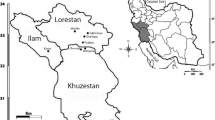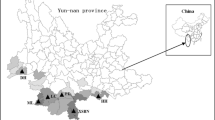Abstract
Dracocephalum kotschyi pois’ (Zarrin-Giah) is an endemic endangered medicinal plant in Iran. In this study, 30 inter-simple sequence repeat (ISSR) markers were used to detect genetic relationships among 54 wild individuals from five endemic populations of D. kotschyi. Primers amplified 263 bands, of which 242 (92.1%) were polymorphic. Cluster analysis, population inference, and principal coordinates analysis revealed a broad genetic variation among the populations. The highest intrapopulation diversity was observed within the Arak population. Gst and Nm mean indices of the populations were found to be 0.27 and 1.31, respectively. Analysis of molecular variance showed that the mean genetic diversities within and among the populations were 74% and 26%, respectively. The most similarity was between Isfahan and Alborz populations, whereas the least similarity was between Arak and Tehran. Based on STRUCTURE analysis, samples were divided into four groups. The findings of this work indicate that ISSR analysis could be a suitable technique for genotyping and characterizing D. kotschyi populations. Information on diversity, found in this study, will help to conserve, domesticate and cultivate D. kotschyi for nutraceutical and pharmaceutical uses.






Similar content being viewed by others
References
Bossdorf O, Auge H, Lafuma L, Rogers WE, Siemann E, Prati D (2005) Phenotypic and genetic differentiation between native and introduced plant populations. Oecologia 144:1–11
Botstein D, White RL, Skolnick M, Davis RW (1980) Construction of a genetic linkage map in man using restriction fragment length polymorphisms. Am J Hum Genet 32:314
Doyle J, Doyle J (1987) A rapid procedure for DNA purification from small quantities of fresh leaf tissue. Phytochem Bull 19:11–15
Evanno G, Regnaut S, Goudet J (2005) Detecting the number of clusters of individuals using the software STRUCTURE: a simulation study. Mol Ecol 14:2611–2620
Fattahi M, Nazeri V, Sefidkon F, Zamani Z, Palazon J (2011) The effect of pre-sowing treatments and light on seed germination of Dracocephalum kotschyi Boiss: an endangered medicinal plant in Iran. Hortic Environ Biotechnol 52:559–566
Golshani S, Karamkhani F, Monsef-Esfehani HR, Abdollahi M (2004) Antinociceptive effects of the essential oil of Dracocephalum kotschyi in the mouse writhing test. J Pharm Pharm Sci 7:76–79
Hadian J, Karami A, Azizi A, Khadivi-Khub A (2015) Ubiquitous genetic diversity among and within wild populations of Satureja rechingeri assessed with ISSR markers. Plant Syst Evol 301:923–930
Hajjar R, Jarvis DI, Gemmill-Herren B (2008) The utility of crop genetic diversity in maintaining ecosystem services. Agric Ecosyst Environ 123:261–270
Hamrick J (1987) Gene flow and distribution of genetic variation in plant populations. In: Differentiation patterns in higher plants, pp 53–67
Hamrick J (1989) Isozymes and the analysis of genetic structure in plant populations. In: Soltis DE, Soltis PS, Dudley TR (eds) Isozymes in plant biology. Springer, Berlin, pp 87–105
Ibitoye D, Akin-Idowu P (2010) Marker-assisted-selection (MAS): a fast track to increase genetic gain in horticultural crop breeding. Afr J Biotechnol 9:8889–8895
Jahaniani F, Ebrahimi SA, Rahbar-Roshandel N, Mahmoudian M (2005) Xanthomicrol is the main cytotoxic component of Dracocephalum kotschyii and a potential anti-cancer agent. Phytochemistry 66:1581–1592
Kumar A, Arya L, Kumar V, Sharma S (2006) Inter simple sequence repeat (ISSR) analysis of cytoplasmic male sterile, male fertile lines and hybrids of pearl millet [Pennisetum glaucum (L.) R. Br.]. Indian J Crop Sci 1:117–119
Kumar A, Mishra P, Singh SC, Sundaresan V (2014) Efficiency of ISSR and RAPD markers in genetic divergence analysis and conservation management of Justicia adhatoda L., a medicinal plant. Plant Syst Evol 300:1409–1420
Liao L, Guo Q-s, Wang Z-y, Liu L, Zhu Z-b (2012) Genetic diversity analysis of Prunella vulgaris in China using ISSR and SRAP markers. Biochem Syst Ecol 45:209–217
Liu J, Wang L, Geng Y, Wang Q, Luo L, Zhong Y (2006) Genetic diversity and population structure of Lamiophlomis rotata (Lamiaceae), an endemic species of Qinghai-Tibet Plateau. Genetica 128:385–394
Lowe A, Harris S, Ashton P (2009) Ecological genetics: design, analysis, and application. Wiley, New York
Mohammadi S, Prasanna B (2003) Analysis of genetic diversity in crop plants-salient statistical tools and considerations. Crop Sci 43:1235–1248
Nei M (1978) Estimation of average heterozygosity and genetic distance from a small number of individuals. Genetics 89:583–590
Nei M, Li W-H (1979) Mathematical model for studying genetic variation in terms of restriction endonucleases. Proc Natl Acad Sci 76:5269–5273
Noroozisharaf A, Hamidoghli Y, Zakizadeh H (2011) In vitro seed germination and micropropagation of primrose (Primula heterochroma Stapf.) an endemic endangered Iranian species via shoot tip explants. Hortic Environ Biotechnol 52:298–302
Noroozisharaf A, Hatamzadeh A, Samizadeh Lahiji H, Bakhshi D (2015) Genetic diversity of endangered primrose (Primula heterochroma Stapf.) accessions from Iran revealed by ISSR and IRAP markers. Sci Hortic 190:173–178
Pank F (2006) Breeding of medicinal plants. In: Medicinal plant biotechnology: from basic research to industrial applications, pp 417–449
Peakall R, Smouse PE (2006) GENALEX 6: genetic analysis in Excel. Population genetic software for teaching and research. Mol Ecol Not 6:288–295
Powell W, Morgante M, Andre C, Hanafey M, Vogel J, Tingey S, Rafalski A (1996) The comparison of RFLP, RAPD, AFLP and SSR (microsatellite) markers for germplasm analysis. Mol Breed 2:225–238
Prevost A, Wilkinson M (1999) A new system of comparing PCR primers applied to ISSR fingerprinting of potato cultivars. Theor Appl Genet 98:107–112
Pritchard JK, Stephens M, Donnelly P (2000) Inference of population structure using multilocus genotype data. Genetics 155:945–959
Rahimmalek M, Bahreininejad B, Khorami M, Sayed T (2009) Genetic diversity and geographical differentiation of Thymus daenensis, an endangerd medicinal plant, as revealed by Inter Simple Sequence Repeat (ISSR) markers. Biochem Genet 47:831–842
Rao VR, Hodgkin T (2002) Genetic diversity and conservation and utilization of plant genetic resources. Plant Cell Tissue Organ Cult 68:1–19
Reddy MP, Sarla N, Siddiq E (2002) Inter simple sequence repeat (ISSR) polymorphism and its application in plant breeding. Euphytica 128:9–17
Reisch C, Anke A, Röhl M (2005) Molecular variation within and between ten populations of Primula farinosa (Primulaceae) along an altitudinal gradient in the northern Alps. Basic Appl Ecol 6:35–45
Rohlf FJ (1998) On applications of geometric morphometrics to studies of ontogeny and phylogeny. Syst Biol 47:147–158
Rohlf FJ, Sokal RR (1981) Comparing numerical taxonomic studies. Syst Biol 30:459–490
Saeidnia S, Gohari AR, Uchiyama N, Ito M, Honda G, Kiuchi F (2004) Two new monoterpene glycosides and trypanocidal terpenoids from Dracocephalum kotschyi. Chem Pharm Bull 52:1249–1250
Saeidnia S, Gohari AR, Hadjiakhoondi A, Shafiee A (2007) Bioactive compounds of the volatile oil of Dracocephalum kotschyi. Z Naturforsch C J Biosci 62:793–796
Sefc K, Lopes M, Lefort F, Botta R, Roubelakis-Angelakis K, Ibanez J, Pejić I, Wagner H, Glössl J, Steinkellner H (2000) Microsatellite variability in grapevine cultivars from different European regions and evaluation of assignment testing to assess the geographic origin of cultivars. Theor Appl Genet 100:498–505
Shannon CE, Weaver W (1949) The mathematical theory of communication. University of Illinois Press, Urbana
Shao J-W, Chen W-L, Peng Y-Q, Zhu G-P, Zhang X-P (2009) Genetic diversity within and among populations of the endangered and endemic species Primula merrilliana in China. Biochem Syst Ecol 37:699–706
Shi W, Yang CF, Chen JM, Guo YH (2008) Genetic variation among wild and cultivated populations of the Chinese medicinal plant Coptis chinensis (Ranunculaceae). Plant Biol 10:485–491
Sokal RR (1958) A statistical method for evaluating systematic relationship. Univ Kans Sci Bull 28:1409–1438
Song Z, Li X, Wang H, Wang J (2010) Genetic diversity and population structure of Salvia miltiorrhiza Bge in China revealed by ISSR and SRAP. Genetica 138:241–249
Vicente MJ, Segura F, Aguado M, Migliaro D, Franco JA, Martínez-Sánchez JJ (2011) Genetic diversity of Astragalus nitidiflorus, a critically endangered endemic of SE Spain, and implications for its conservation. Biochem. Syst. Ecol 39:175–182
Wang Y, Li D, Sui C, Zhao A, Du X (2008) Conservation, characterization, evaluation and utilization of Chinese jujube germplasm resources. In: I International Jujube Symposium, vol. 840, pp 235–240
Yang B, Xiao B, Chen X, Shi C (2007) Assessing the genetic diversity of tobacco germplasm using intersimple sequence repeat and inter-retrotransposon amplification polymorphism markers. Ann Appl Biol 150:393–401
Zhang L-J, Dai S-L (2010) Genetic variation within and among populations of Orychophragmus violaceus (Cruciferae) in China as detected by ISSR analysis. Genet Resour Crop Evol 57:55–64
Acknowledgements
This work was supported by the Grant 9277 by Bu-Ali Sina University to A.A.
Author information
Authors and Affiliations
Corresponding author
Ethics declarations
Conflict of interest
The authors declare they have no conflict of interest.
Additional information
Communicated by Sung-Chur Sim.
Publisher's Note
Springer Nature remains neutral with regard to jurisdictional claims in published maps and institutional affiliations.
Rights and permissions
About this article
Cite this article
Maskani Sereshkeh, F., Azizi, A. & Noroozisharaf, A. Structure of genetic diversity among and within populations of the endemic Iranian plant Dracocephalum kotschyi. Hortic. Environ. Biotechnol. 60, 767–777 (2019). https://doi.org/10.1007/s13580-019-00149-1
Received:
Revised:
Accepted:
Published:
Issue Date:
DOI: https://doi.org/10.1007/s13580-019-00149-1




